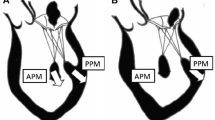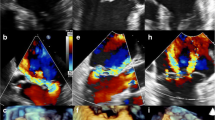Abstract
Background
Mitral valve repair is a feasible treatment option in patients with rheumatic mitral valve disease, but it is not always successful. Mitral valve replacement is generally the surgical treatment of choice in such patients. We aimed to examine whether the Wilkins score can predict the feasibility of surgical repair in such patients.
Methods
Mitral valve surgery was performed on 14 patients by the same surgeon (A.A.). Five patients underwent mitral valve repair (group I), and nine patients underwent mitral valve replacement (group II). The Wilkins scores were determined by assessing echocardiography findings. The selection of mitral valve repair or replacement was based on the intraoperative findings and the preferences of the same surgeon (A.A.). In group I, we performed chordal reconstruction, augmentation of the posterior leaflet, resection of chordae, decalcification of the commissure, commissurotomy, slicing of the anterior leaflet, division of the papillary muscle, and ring annuloplasty in various combinations.
Results
There were no significant differences between the two groups with regard to any component of the preoperative Wilkins score. There was no significant difference in the pre- and postoperative scores in group I; however, the mitral valve orifice area was significantly improved after the operation (pre- and postoperative mean values: 1.3 ± 0.3 and 2.0 ± 0.4, P < 0.05).
Conclusion
Mitral valve repair is effective in treating rheumatic mitral stenosis. However, the Wilkins score may not be useful in predicting the feasibility of mitral repair.


Similar content being viewed by others
References
Yau TM, El-Ghoneimi YA, Armstrong S, Ivanov J, David TE. Mitral valve repair and replacement for rheumatic disease. J Thorac Cardiovasc Surg. 2000;119:53–61.
Wilkins GT, Weyman AE, Abascal VM, Block PC, Palacios IF. Percutaneous balloon dilatation of the mitral valve: an analysis of echocardiographic variables related to outcome and the mechanism of dilatation. Br Heart J. 1988;60:299–308.
Baumgartner H, Hung J, Bermejo J, Chambers JB, Evangelista A, Griffin BP, American Society of Echocardiography, et al. European Association of Echocardiography. Echocardiographic assessment of valve stenosis: EAE/ASE recommendations for clinical practice. J Am Soc Echocardiogr. 2009;22:1–23.
Gillinov AM, Blackstone EH, Alaulaqi A, Sabik JF 3rd, Mihaljevic T, Svensson LG, et al. Outcomes after repair of the anterior mitral leaflet for degenerative disease. Ann Thorac Surg. 2008;86:708–17.
Chmielak Z, Ruzyllo W, Demkow M, Soroka M, Karcz M, Konka M, et al. Late results of percutaneous balloon mitral commissurotomy in patients with restenosis after surgical commissurotomy compared to patients with ‘de-novo’ stenosis. J Heart Valve Dis. 2002;11:509–16.
Martínez-ríos MA, Tovar S, Luna J, Eid-Lidt G. Percutaneous mitral commissurotomy. Cardiol Rev. 1999;7:108–16.
Arora R, Kalra GS, Singh S, Mukhopadhyay S, Kumar A, Mohan JC, et al. Percutaneous transvenous mitral commissurotomy: immediate and long-term follow-up results. Catheter Cardiovasc Interv. 2002;55:450–6.
Padial LR, Abascal VM, Moreno PR, Weyman AE, Levine RA, Palacios IF. Echocardiography can predict the development of severe mitral regurgitation after percutaneous mitral valvuloplasty by the Inoue technique. Am J Cardiol. 1999;83:1210–3.
Padial LR, Freitas N, Sagie A, Newell JB, Weyman AE, Levine RA, et al. Echocardiography can predict which patients will develop severe mitral regurgitation after percutaneous mitral valvulotomy. J Am Coll Cardiol. 1996;27:1225–31.
Mezilis NE, Salame MY, Oakley GD. Predicting mitral regurgitation following percutaneous mitral valvotomy with the Inoue balloon: comparison of two echocardiographic scoring systems. Clin Cardiol. 1999;22:453–8.
Wang YC, Tsai FC, Chu JJ, Lin PJ. Midterm outcomes of rheumatic mitral repair versus replacement. Int Heart J. 2008;49:565–76.
Ailawadi G, Swenson BR, Girotti ME, Gazoni LM, Peeler BB, Kern JA, et al. Is mitral valve repair superior to replacement in elderly patients? Ann Thorac Surg. 2008;86:77–86.
Acknowledgment
Masao Daimon is partially supported by a Grant-in-Aid for Scientific Research C (20500427) from the Japan Society for the Promotion of Science and a Grant-in-Aid for Scientific Research (20231501) from the Ministry of Health, Labour and Welfare.
Author information
Authors and Affiliations
Corresponding author
Rights and permissions
About this article
Cite this article
Makinae, H., Daimon, M., Tambara, K. et al. Reconsiderations of mitral stenosis: rheumatic mitral valve repair and the Wilkins score. J Echocardiogr 8, 106–111 (2010). https://doi.org/10.1007/s12574-010-0052-y
Received:
Revised:
Accepted:
Published:
Issue Date:
DOI: https://doi.org/10.1007/s12574-010-0052-y




